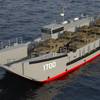A senior Navy official is warning that rising costs in key programs such as Lockheed Martin and General Dynamics' next-generation surface combat ships could derail efforts by the department to modernize its fleet and aircraft.
The Navy has awarded contracts for four ships that initially were estimated to cost $270 million each under the Littoral Combat Ship (LCS) program, two to Bethesda, Md.-based Lockheed Martin Corp. and two to Falls Church, Va.-based General Dynamics Corp. But the cost of Lockheed's first ship - which is roughly 73 percent completed - has already soared to roughly $350 million, according to the Navy.
The Navy ordered a halt to work on the Lockheed's second ship in January while it conducted a program review. Last month, Navy Secretary Donald Winter said he would allow Lockheed to resume work on the ship at its Wisconsin shipyard if the company agreed by mid-April to switch to a fixed-price contract.
Lockheed hasn't yet agreed to do so and is currently in negotiations with the Navy to restructure its contract for both ships. The first ship had been scheduled to be delivered to the Navy this summer and work on the second was to have started last month.
General Dynamics' shipbuilding unit in Mobile, Ala., is on track to deliver on schedule its first ship, which is roughly 40 percent complete, by spring 2008, said spokesman Kendell Pease. The company has been put on close watch by the Navy to track costs, but has not been asked to restructure its contracts, he said.
Lockheed has said cost overruns were due to revised Navy requirements. However, Admiral Mullen said a compressed schedule and the lack of greater oversight were additional factors leading to significant cost increases.
The LCS ships, longer than a football field and carrying up to 75 crew members, have relatively flat hulls that will make them the only large ships in the Navy's fleet able to operate in waters as shallow as 16 feet. They are designed to carry three H-60 helo helicopters and three unmanned drone aircraft, and are planned for multiple types of missions including anti-submarine, mine and surface warfare.
Since the Navy's March 15 announcement that it is seeking a fixed-price contract for the LCS program, shares of Lockheed have flattened out.
Jefferies & Co. analyst Howard Rubel said the potential impact of the LCS negotiations dwarfs the relatively small percentage of Lockheed's revenues the two ships represent.
Today, the 276 ships in the Navy's battle force fleet is well below the roughly 600 ships during the Reagan years and short of the department's goal of 313 ships. Attack submarines, not including ones with nuclear warheads, have also shrunk by nearly half to 55 from nearly 100 at the time of the Cold War. Large deck aircraft - which are being built at a rate of one new carrier ever five years - could fall to 10 if there is a potential deficit in funds.
The Bush administration's proposed 2008 defense budget requests $38.72 billion for Navy procurement, excluding research and development funding, up from $36.01 billion a year earlier. That includes $12.75 billion for aircraft purchases, compared with $10.84 billion, a year ago; $13.66 billion for ship building, up from $10.53 billion a year before; and $5.8 billion for Marine Corps programs, almost double the $2.99 billion in the previous year.
The Navy's goal is to add seven ships in both fiscal years 2007 and 2008, but industry analysts say Congress would need to boost funding levels by $3 billion to $4 billion each year to meet that target.
Source: AP
Sponsored Content
Chris-Marine’s solutions help to prolong engine lifetime

AST is now AST Networks, bringing you remote connectivity wherever you are

March 2024
 Read the Magazine
Read the Magazine

 Read the Magazine
Read the Magazine
This issue sponsored by:

America’s Watershed Initiative: Sustaining a Critical Waterway
March 2024
 Read the Magazine
Read the Magazine

 Read the Magazine
Read the Magazine
This issue sponsored by:

GAO: Coast Guard Should Better Monitor its Efforts to Credential Merchant Mariners
Subscribe for
Maritime Reporter E-News
Maritime Reporter E-News is the maritime industry's largest circulation and most authoritative ENews Service, delivered to your Email five times per week










